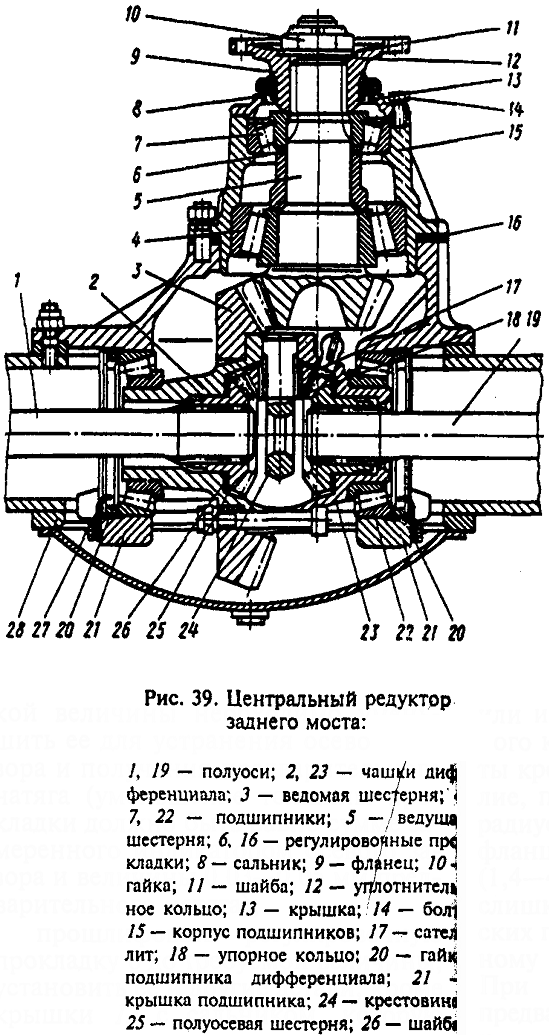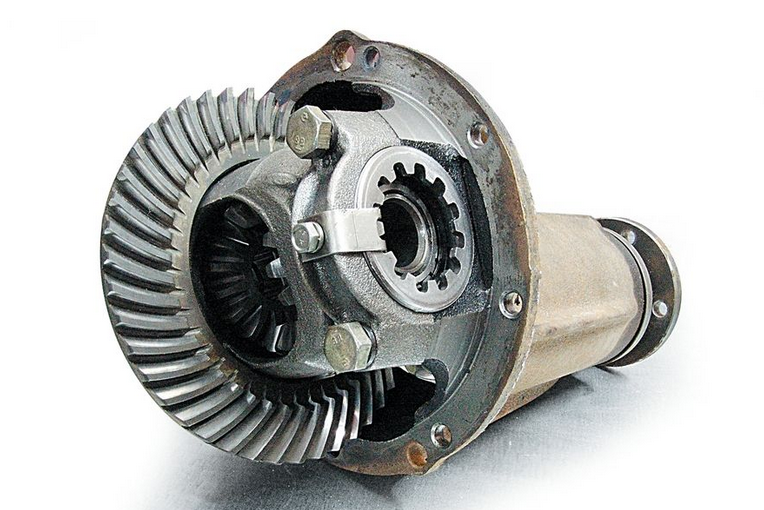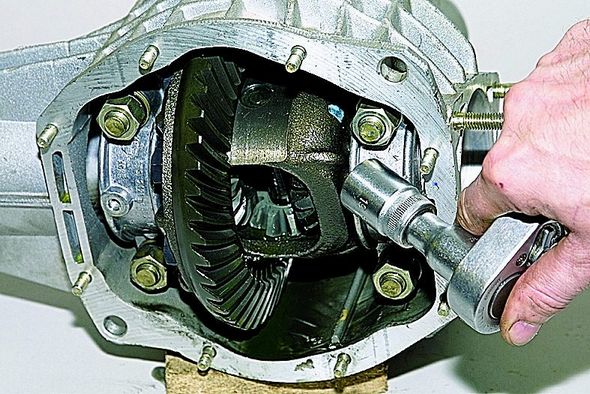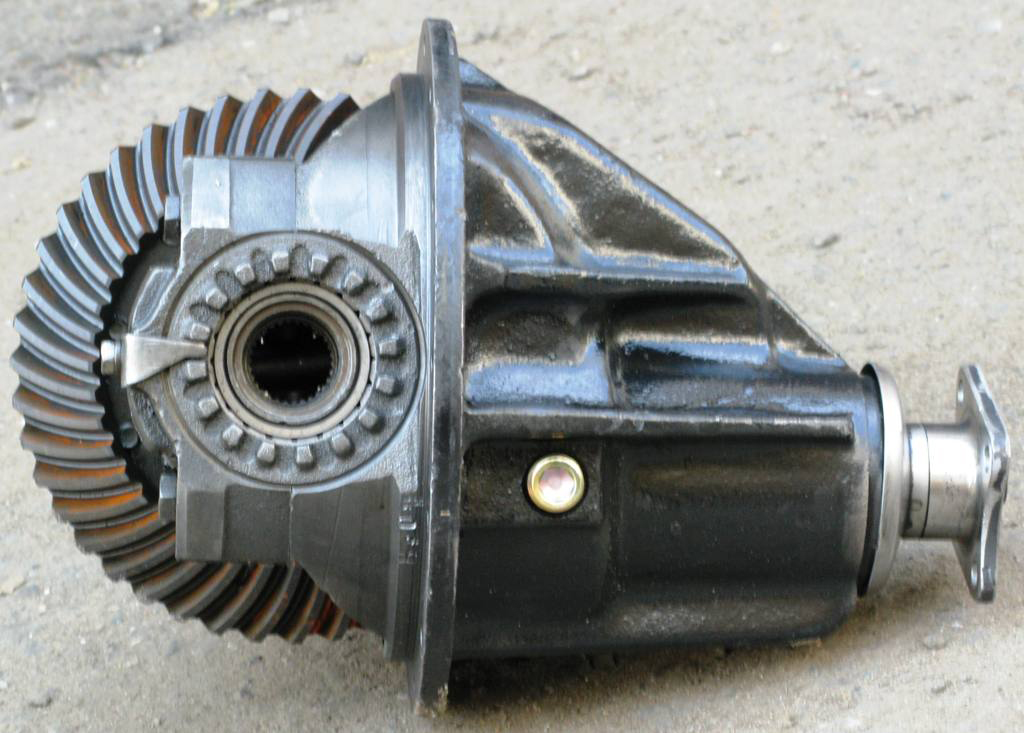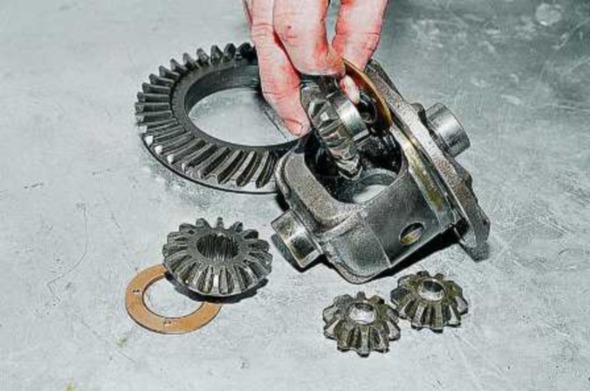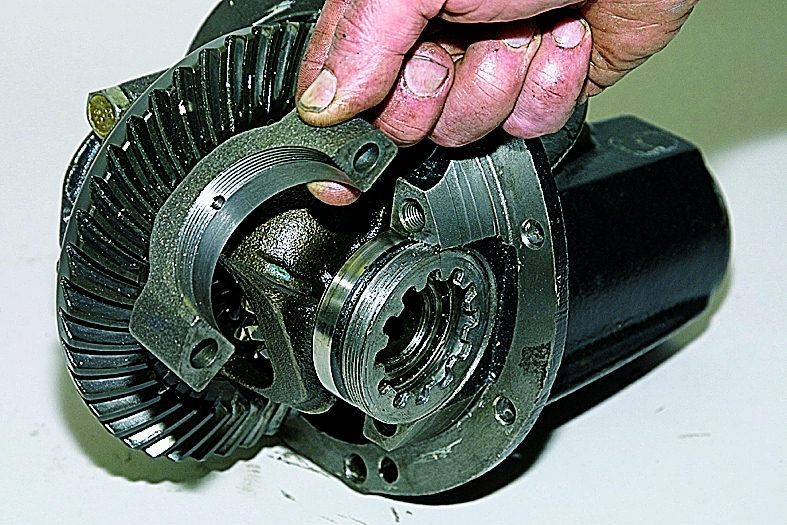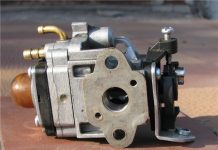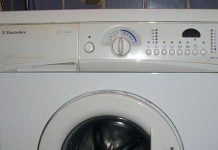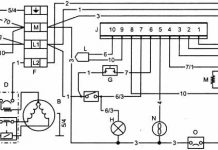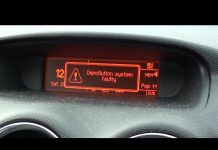In detail: do-it-yourself maz gearbox repair from a real master for the site my.housecope.com.
The rear axle is adjusted after checking the axial clearance in the bearings of the drive bevel gear.
Every 60-80 thousand kilometers, it is recommended to check the axial clearance in the bearings of the drive bevel gear 5 (see Fig. 39) with the cardan shaft removed and the nut tightened with a torque of 450-600 N * m (45-60 kgf * m) 10 flange mounting.
The axial clearance is checked using an indicator device by moving the drive gear from one extreme position to another. In the absence of an indicator, the presence of axial clearance in the bearings is checked by swinging the drive gear by the propeller shaft flange. If there is an axial clearance in the bearings and its value exceeds 0.05 mm, or if the drive gear moves, it should be adjusted.
Adjustment of the central gearbox includes adjustments:
- pinion shaft bearings;
- differential bearings;
- engagement of bevel gears along the contact patch.
To carry out these adjustments, the central gearbox is removed from the bridge and the necessary partial disassembly of the gearbox is carried out.
For the MAZ-5335 car and its modifications, after adjusting the gear engagement, tighten all the nuts of the studs for fastening the bearing housing to the gearbox housing, install the bearing nut stoppers, wrap the driven gear limiter so as to obtain a minimum clearance of 0.15-0.2 mm between the cracker and driven gear (minimum clearance is set by turning the driven gear one revolution). After that, the limiter is locked with a lock nut.
| Video (click to play). |
When removing the central gearbox from the MA3-5335 vehicle and its modifications (for adjustment or repair), check the gap between the end plane of the side gear and the support washer, which is factory set within 0.5-1.3 mm. The gap is checked with a feeler gauge through the windows in the differential cups, when the satellites are shifted to the support washers to failure, and the side gear is pressed against the satellites, i.e., is in backlash-free engagement with them.
The adjustment of the middle axle of the MAZ-64227 is similar to the previously described adjustment of the rear axle central gearbox.
To check the presence of axial clearance in the bearings of the drive gear 25 (Fig. 41) and, if necessary, to make adjustments, remove the central gearbox, remove the differential lock mechanism 20, the stuffing box cover, remove the axle drive shaft 30 with the center differential 29, turning the shaft 30 until the shooting is installed on differential cups against the gear, remove the crankcase 7. After that, by unscrewing the fastening nuts, remove the crankcase 8 bearings with gear 3.
The design of the drive axles allows you to perform most repairs without removing them from the vehicle.
It is recommended to disassemble the central gearboxes of the middle and rear axles using a universal puller (Fig. 59) and a set of mandrels (Fig. 60) to it.
To replace the oil seal of the drive bevel gear, you must:
Disconnect the cardan shaft;
· unscrew the flange fastening nut 9 (see Fig. 55), remove the washer, seal and flange;
· unscrew the bolts and remove the cover 13 with the stuffing box;
Replace the stuffing box, avoiding distortion and damage, filling its internal cavities with Litol-24 grease, and assemble the assembly in the reverse order.
The stuffing box is pressed into the cover to a depth of 6 mm from the front end of the cover using a mandrel (Fig. 61). Tighten the flange fastening nut 10 with a torque of 45-60 kgf.m.
To remove the gearbox, do the following:
Drain the oil from the crankcase of the bridge (turning out the drain and filler plugs);
Disconnect the cardan shaft;
· remove covers 9 (see Fig. 56) of wheel gears, take out axle shafts together with drive gears of 4 wheel gears;
Unscrew the nuts of the studs securing the gearbox to the crankcase (with the exception of the top two). After that, roll the trolley with the hoist under the gearbox and, having ensured reliable support of the gearbox on the trolley, unscrew the remaining two upper nuts, then remove the gearbox using two dismantling bolts (in the flange of the gearbox to the axle housing).
It is recommended to dismantle the gearbox on a special rotary stand. In the absence of a stand, you can use a low table - a workbench with a height of 500 - 600 mm.
The sequence for disassembling the gearbox is as follows:
· remove drive gear 5 (see Fig. 55) with bearings as an assembly;
Remove the stoppers and unscrew the nuts 20 of the differential bearings, loosening the bolts securing the covers 21;
Remove covers 21 of differential bearings;
Unscrew the nuts of the bolts of the differential cups and with the help of
disassemble the differential with dismantling bolts (remove satellites, side gears, thrust washers);
Remove, if necessary, bearings 22 of the differential using a universal puller;
Clamp the drive gear in a vise, the jaws of which are covered with soft metal pads, unscrew the nut and remove the drive gear flange 9, the cover 13 with the stuffing box;
Remove housing 15 with bearings;
· remove the inner ring of the inner tapered bearing from the pinion shaft using a universal puller with mandrel b (see fig. 60);
· if necessary, press the outer cages of the drive gear bearings out of the bearing housing using a puller (Fig. 62) without ring 6.
The nominal and permissible without repair dimensions of the parts of the rear and middle axles are given in Table. 9.
In order to make the correct adjustment of the MAZ rear axle, it is necessary to check the presence of axial clearance of all bearings. Therefore, we advise you to check the gap after sixty to eighty kilometers of the car.
When performing repairs, do not forget to dismantle the MAZ cardan.
Using an indicator tool, check for clearance as follows: move the gear from its most extreme position.
However, if you don't have an indicator, do the following.
Grab the cardan flange.
If even a small gap appears (more than 0.05 millimeters), we advise you to adjust the rear axle gearbox for MAZ.
To do this, you need to adjust the position of such units as:
- MAZ differential bearings;
- Gear shaft bearings;
- All gear engagement.
Before that, we recommend dismantling the gearbox from the MAZ axle, after checking the presence of a gap between the washer and the side gear. To do this, use a special tool - a probe.
The distance should be no more than 1.3 and not less than 0.5 millimeters.
The gear bearings must also be checked for clearance. When performing the adjustment, the MAZ gearbox is dismantled. We also remove the mechanism for locking the MAZ differential, the shaft (in the photo the part is indicated by the number 30), the stuffing box cover.
In this case, it is necessary to turn the shaft 30 until the shooting is installed on the unit cups against the gear.
When adjusting the MAZ rear axle gearbox, the crankcase 7 is also removed. To do this, carefully unscrew the fastening nuts. Then take out the crankcase at number 8 with gear at number 3. Read more about replacing the gearbox in MAZ here. You can buy all the necessary spare parts for repairs in the MAZ catalog.
After removal from the car for repair, the central gearbox of the rear axle is disassembled on a workbench with a height of 500-600 mm in the following sequence:
– remove drive gear 5 (see Fig. 1) with bearings as an assembly;
- remove the stoppers and unscrew the nuts 20 of the differential bearings, loosening the bolts securing the covers 21;
– To remove covers 21 differential bearings;
- unscrew the nuts of the bolts of the differential cups and disassemble the differential using the dismantling bolts (remove the satellites, side gears, thrust washers);
– remove, if necessary, bearings 22 of the differential using a universal puller;
- clamp the drive gear in a vice, the jaws of which are covered with soft metal pads, unscrew the nut and remove the drive gear flange 9, cover 13 with the stuffing box;
– remove housing 15 with bearings; remove the inner race of the inner tapered bearing from the pinion shaft using a universal mandrel puller (Fig. 2);
– if necessary, press the outer cages of the drive gear bearings out of the bearing housing using a puller (Fig. 3) without ring 6.
The disassembled parts of the central gearbox are washed and carefully inspected. Check the condition of the working surfaces of the bearings: they should not have crumbled places, cracks, dents, peeling. Rollers and separators should also not be damaged or destroyed. Gear teeth should not have chips and breaks, cracks, chipping of the cementation layer, pitting. Nuts and burrs on gear teeth must be removed and cleaned. The wear of the teeth of bevel gears in terms of thickness is characterized by the amount of lateral clearance with properly adjusted gearing (along the contact patch). The gap is measured with an indicator from the side of the large diameter. With increased noise of the gears of the central gearbox, the side clearance of 0.8-0.9 mm can serve as a basis for replacing the bevel gear pair.
If it is necessary to replace one of the gears, the driving and driven bevel gears must be completely replaced, since at the factory they are matched in pairs according to the contact patch, side clearance and are marked with the same number.
When examining the details of the differential, one should pay attention to the condition of the surface of the necks of the cross, holes and spherical surfaces of the satellites, the bearing surfaces of the side gears of the support washers and the end surfaces of the differential cups. These surfaces must be free of burrs. In case of significant wear or loose fit of the bronze bushing of the satellite, it must be replaced.
The processing of a new bushing should be carried out after pressing it into the satellite up to a diameter of 32 + 0.05 mm. With significant wear of the bronze bearing washers of the side gears, the latter must be replaced. The thickness of the new bronze washers is 1.5 mm. The differential cups, if it is necessary to replace one of them, are replaced as a set.
The gearbox housing is made of malleable cast iron KCh 37-12. The main defects in which the crankcase is restored is the wear of the holes for the crankcase of the bearings and the hole for the rear bearing of the pinion shaft, damage to the threads for the nuts of the differential bearings.
Adjustment of the central gearbox of the MAZ car is carried out with the gearbox removed in the following sequence:
1. Adjust the tapered bearings of the drive bevel gear.
2. Adjust differential bearings.
3. Adjust the meshing of the bevel gears along the contact patch.
This moment can be determined torque wrench on the nut 26 or by measuring the force applied to the hole on the flange for the propeller shaft mounting bolts. The force applied perpendicular to the radius of the holes on the flange should be 1.3-3.9 kg. It should be remembered that too much tension in tapered bearings leads to their strong heating and rapid wear. With normal bearing preload, remove the nut from the drive gear shaft, noting its position, and the flange; reinstall the cover 24 with the stuffing box and finally assemble the assembly.
Before adjusting the bearings of the differential and adjusting the meshing of the bevel gears of the final drive, it is necessary to unscrew the strain limiter 4.
Differential Bearing Adjustment is carried out using nuts 9 and 15, which must be screwed to the same depth so as not to disturb the position of the gear until the desired preload in the bearings is obtained.
Preload bearings is determined by the amount of torque required to rotate the differential, which should be in the range of 0.2-0.3 kGm (with the drive bevel gear removed).
This moment is determined by a special torque wrench or by measuring the force applied on the radius of the differential cups and equal to 2.3-3.5 kg.
The procedure for checking and adjusting the engagement of MAZ bevel gears is as follows:
1. Before installing the crankcase, 19 bearings with the drive gear into the gear housing, wipe the teeth of the bevel gears dry and lubricate 3-4 teeth of the drive gear with a thin layer of paint over their entire surface.
2. The crankcase 19 with the drive gear is installed in the gear case, the nuts are screwed onto four crosswise studs and the drive gear is turned by the flange 25 (in one direction and the other).
3. Based on the imprints (contact spots) obtained on the teeth of the driven gear, it is established, guided by the instructions in Table 1, the correct engagement of the gears and the nature of the engagement adjustment.
4. Guided table 1, regulate the gear engagement by changing the number of gaskets 29 under the drive gear bearing housing flange and using nuts 9 and 15, without violating the adjustment of the differential bearings. In order to move the drive gear away from the driven gear, it is necessary to place additional adjusting shims under the crankcase flange, and if it is necessary to bring the gears closer together, remove the shims.
For moving driven gear use nuts 9 and 15.
In order not to disturb the adjustment (bearings 33 of the differential, it is necessary to wrap (unscrew) nuts 9 and 15 at the same angle.
When adjusting the engagement (along the contact patch) on the gear teeth, it is necessary to maintain the necessary lateral clearance between the teeth, the value of which for a new pair of gears should be in the range of 0.2 to 0.5 mm. Decrease side clearance between the teeth of the gears due to the displacement of the contact patch from the recommended position is not allowed, as this leads to a violation of the correct engagement of the gears and their rapid wear.
After finishing the adjustment gear engagement it is necessary to tighten all the nuts of the studs for fastening the bearing housing to the gearbox housing, put the stoppers of the bearing nuts, tighten the limiter so as to obtain a minimum clearance of 0.15-0.2 mm between the cracker and the driven gear (the minimum clearance is set when the driven gear is rotated one turn) . After that, the limiter 4 must be locked with a lock nut.
When withdrawing central gearbox from the car MAZ (for adjustment or repair), it is necessary to check the gap between the end plane of the side gear and the support washer, which is factory set within 0.5-1.3 mm.
The gap is checked with a feeler gauge through the windows in the differential cups, when the satellites are shifted to the support washers to failure, and side gear pressed against the satellites, i.e. is in close contact with them.
Table 1. Adjusting the meshing of the bevel gears of the central gearbox
The position of the contact patch on the driven gear
Adjustment of the central gearbox of the rear axle of cars MA3-5335, MAZ-5549, MAZ-5429, MA3-5430, MAZ-504V
The adjustment of the central gearbox must be carried out with the gearbox removed in the following sequence:
1. Adjust the tapered bearings of the drive bevel gear.
2. Adjust differential bearings.
3. Adjust the meshing of the bevel gears along the contact patch.
To adjust the bearings of the drive bevel gear, you must:
1. Disassemble the parking brake, remove the caliper from the crankcase 19 (Fig. 21).
3.Unscrew the nuts of the studs of the crankcase of the drive gear bearings and using the dismantling bolts 6 remove the crankcase 19 with the drive bevel gear assembly.
4. Having fixed the crankcase 19 in a vice, determine the axial play of the bearings with an indicator.
5. Having freed the crankcase 19, clamp the driving bevel gear in a vice (put soft metal pads on the jaws of the vise). Unpin and unscrew the flange nut 26, remove the washer and flange. Remove the cover using the dismantling bolts. Remove oil deflector 23, front bearing inner race and shim 21.
6. Measure the thickness of the adjusting washer and calculate to what value it is necessary to reduce it to eliminate the axial play and obtain a preload (the decrease in the thickness of the washer should be equal to the sum of the shaft axial play measured by the indicator and the value of 0.03-0.05 mm preload).
7. Grind the adjusting washer to the required size, install it and other parts, except for cover 24 with an oil seal, which should not be installed, since the friction of the oil seal against the neck of the flange will not allow you to accurately measure the moment of resistance to turning the gear in the bearings. When tightening the flange nut, the bearing housing must be rotated to ensure that the rollers are properly seated in the bearing races.
8. Check the preload of the bearings in terms of the moment required to turn the drive gear, which should be equal to 0.1-0.3 kgf • m.
This moment can be determined with a torque wrench on nut 26 or by measuring the force applied to the hole on the flange for the propeller shaft mounting bolts. The force applied perpendicular to the radius of the hole on the flange should be 1.3-3.9 kg. It should be remembered that too much preload in tapered bearings leads to their strong heating and rapid wear. With normal bearing preload, remove the nut from the drive gear shaft, noting its position, and the flange; reinstall the cover 24 with the stuffing box and finally assemble the assembly.
Table 3
Adjusting the meshing of the bevel gears of the central gearbox
Before adjusting the bearings of the differential and adjusting the meshing of the bevel gears of the final drive, it is necessary to unscrew the strain limiter 4.
Adjustment of the tightening of the differential bearings is carried out using nuts 9 and 15, which must be screwed to the same depth so as not to disturb the position of the gear, until the desired preload in the bearings is obtained.
The preload of the bearings is determined by the amount of torque required to rotate the differential, which should be within 0.2-0.3 kgf * m (with the drive bevel gear removed).
This moment is determined by a special torque wrench or by measuring the force applied on the radius of the differential cups and equal to 2.3-3.5 kg.
The procedure for checking and adjusting the engagement of bevel gears is as follows:
1. Before installing the crankcase, 19 bearings with a drive gear into the gear housing, wipe the teeth of the bevel gears dry and lubricate 3-4 teeth of the drive gear with a thin layer of paint over their entire side surface.
2. Install the crankcase 19 with the drive gear into the gearbox housing, wrap the four nuts of the studs lying crosswise and turn the drive gear by the flange 25 (in one direction and the other).
3. According to the prints (contact spots) obtained on the teeth of the driven gear, they are installed, guided by the instructions in Table. 3, the correct meshing of the gears and the nature of the meshing adjustment.
4. Guided by the table. 3, adjust the gear engagement by changing the number of spacers 29 under the drive gear bearing housing flange and using nuts 9 and 15, without violating the adjustment of the differential bearings.In order to move the drive gear away from the driven gear, it is necessary to place additional adjusting shims under the crankcase flange, and if it is necessary to bring the gears closer together, remove the shims.
To move the driven gear, nuts 9 and 15 are used.
In order not to disturb the adjustment of bearings 33 of the differential, it is necessary to wrap (unscrew) nuts 9 and 15 at the same angle.
Rear axle reducer is a hypoid mechanical device, where there is a shank (drive gear), and the plane of the driven gear intersects, creating a torque character by means of angular transformation.
To perform such actions, we need: a strong thread, a torque wrench, adjusting rings, fine sandpaper and a caliper.
The gearbox must be adjusted if a hum occurs at speeds exceeding 30 km / h. The cause of such a failure of the device, as a rule, is the prolonged operation of the car in difficult conditions. Constant overload, driving with a trailer.
Initially, you need to check reducer. It is necessary to brush all the elements with a brush, wash them in kerosene. If any defects are visible (damage to the gear teeth), then it is imperative to replace the damaged part. Look at the edges at the top of the teeth and the working surface - they should be sharp. In the case of the presence of roundings, nicks, it is worth changing the main pair. Minor defects are eliminated with fine sandpaper, later polished.
During the assembly period of the gearbox, install the spacer sleeve, a new flange nut, and the collar. If you assemble the device in an old crankcase, then calculate the change in the indicators of the drive gear, adjusting ring. This is how you will determine the difference in thickness deviation between the new and old-style gears. Such designations are marked with marks “-”, “+”, the unit of measurement is hundredths of mm, the data is present on the shaft at the drive gear. We clean the seats under the bearings with a fine sandpaper, a sliding fit should form. Then we press the outer races of the bearings into the crankcase. We install the inner ring at the rear bearing in the crankcase. Now we fix the flange from the drive gear, fix the inner ring of the front bearing with a nut, up to a moment of 1 kgf.m.
We install the crankcase with a level in a horizontal position. In order to clarify the gap format of the plate and the round rod, which is placed in the bearing bed, we will use a flat feeler gauge. The resulting difference will reflect the thickness of the adjusting ring itself. We use a piece of pipe that is suitable as a mandrel. We install an adjusting ring on the shaft. The shaft itself is mounted in the crankcase. We form the parts in the following order: the spacer sleeve and the inner ring from the front bearing, then the cuff, the drive gear flange. We tighten the nut with a torque wrench until the moment of 12 kgf.m. We tightly wrap a strong thread on the neck of the flange, hooking a dynamometer to it. So we find out the moment of scrolling formed at the drive gear shaft. The flange should rotate with a force of up to 9.5 kgf if new bearings are installed. If not, tighten the nut.
The tightening torque should not exceed the parameter 26 kgf.m. Otherwise, the gearbox itself will have to be disassembled, replacing the spacer sleeve. Install the crankcase with bearings in the differential housing. The bearing cover is fixed with bolts. If there is axial play on the gears of the axle shafts, then put a thicker adjusting ring. Half shaft gears must be tightly installed. Here you can use a steel key (thickness 3 mm).
Then adjust the tension of the bearings of the differential, the gap present in the main pair. To check the distance at the covers, we will use a caliper. Tighten the second nut until it stops. Such a gap between the covers will be slightly larger, by 0.1 millimeters.During the rotation of the first nut e, we set the gap in engagement. A slight knock of the teeth will be accompanied by a proper repair. Then both nuts are tightened, the size of the gap in the engagement is controlled. The nuts are tightened until the distance at the covers is no more than the standard 0.2 millimeters. Then the driven gear is rotated three turns, checking the play in the engagement of each pair of teeth. Install stop plates.
The serviceability of the gearbox should be constantly monitored, since its breakdown can disable the cardan shaft. In addition, you must constantly monitor the gear oil and change it regularly. In the article I will tell you how the gearbox is arranged, how to correctly diagnose, adjust and repair it.
The rear axle gearbox is involved in the transmission of engine power to the wheels. The main components of the gearbox are: main gear (GP) and cross-axle differential. With the help of a gearbox, the rotation speed changes when the force is transferred from device to device. The design of the gearbox is almost the same for different vehicles.
- driving and driven gears;
- direction pin;
- glands;
- drum;
- bearings and their fastenings;
- locking plate;
- breather;
- shank and many other details.
The main gear consists of 2 gears: leading and driven. Due to the fact that they are in hypoid gearing, the gear teeth have good longitudinal sliding. Thus, the service life is extended and the noise during operation of the gearbox is reduced. Engine power is transmitted first to the driving gear and then to the driven gear. Thanks to this pair, the magnitude of the moment and its direction change.
GP can be single and double. It is used to transfer the engine torque to the wheels. Double transmissions are divided into central and spaced. In doubles, the main load falls on the elements of the system, they have a large gear ratio and have a simple design. Diversified gears can increase ground clearance, but they are more complex, more compact and more efficient.
Single gear can be:
- cylindrical. In this case, the gears are in the same plane, have maximum efficiency;
- hypoid. It has a small weight, smaller overall dimensions and average efficiency;
- conical. In this case, the gears are located perpendicular to each other, so the design takes up a lot of space. Has a high efficiency;
- worm. It is compact, silently works, but has the lowest efficiency.
The most common is the hypoid gear. On closer examination of this gear, you can see that its teeth are located at a slight angle to each other. This reduces the load on the teeth and ensures quiet and smooth operation.
Cross-axle differential works in tandem with the main gear. It includes the driven gear, the gears of the axle shafts and the gears of the satellites. Through the driven gear, engine power is transmitted to the axle shafts, which transmit it to the wheels. Thus, the differential serves to distribute power between the axle shafts, allowing them to spin at different speeds when changing direction. This principle is applied to cars with rear wheel drive. This design has shown reliability and ability to work in the most difficult conditions.
The rear axle gearbox is under the most stress, so it must be correctly assembled and free of any defects. Only in this case it will last long enough. The service life of the gearbox depends on its care, as well as on the adjustment of the rear axle gearbox.
The basis for diagnosing the rear axle gearbox is the noise that has appeared from behind the car. This may be a sign of device wear. If a hum appears, then this indicates that the gearbox has become unusable and requires a major overhaul, in which almost all parts will have to be changed.To prevent this condition, it is necessary to make diagnostics in time at the slightest noise.
As a rule, various types of noise appear at certain speeds. For each type of noise, you can determine what deviations and with what parts or assemblies they are associated. If noise appears in the rear axle, the condition of the drive axle and gearbox should be checked under different driving modes: movement from a standstill, acceleration, movement at low speeds, etc. Noises during such tests can be divided into the following types:
- continuous noise from the rear wheels;
- noise during acceleration of the car;
- noise during braking (slow motion);
- noise that occurs when cornering.
After diagnosing by changing the driving modes, you can determine the cause of the malfunction and roughly draw up the amount of repair work.
If the gearbox is out of order, then there are two ways to solve the problem: replace the entire unit or find the faulty part and replace it. To perform the replacement procedure, you will need a standard set of tools. First of all, oil must be drained from the unit housing. To do this, unscrew the drain plug at the bottom of the rear axle. Next, the rear wheels, brake drums, and pads are removed. Using the socket wrench, the axle shaft mounts are unscrewed. Then the axle shafts are dismantled.
When dismantling the cardan shaft, there are some features. Before unscrewing the bolts holding the shaft, it is necessary to note the position of the cardan flange and the gearbox flange relative to each other in order to correctly install them during reassembly to avoid imbalance. During assembly, the nuts will need to be replaced with new ones so that they do not loosen and the propeller shaft does not break when the car is moving.
Now, with the help of a socket wrench, the bolts with which the gearbox is attached to the bridge are unscrewed. After all these procedures, you can remove the old unit and put a new one in its place, or a repaired one and you can adjust the gearbox. Assembly must be done in exactly the reverse order. Oil should be filled with new.
Adjustment of the rear axle gearbox is performed when a hum appears in the rear wheels. The cause of the hum may be constant loads on the car or mechanical damage. You should start with a visual inspection of the details. Bearings, oil seals, satellites, flanges and axles are removed from the machine. All parts must be washed in kerosene and visually inspected. If even one tooth is damaged, the part must be replaced with a new one.
After inspection and replacement of parts, the gearbox is assembled. First, the drive gear with shim, spacer, bearings and flange is installed. To tighten the nut, a special wrench with a built-in dynamometer is used. The nut must be tightened by 1 Newton. Next, the driven gear is installed in the differential housing and the bolts are tightened. Now you need to adjust the backlash. When everything is installed, the nuts should be tightened to a minimum. Next, the driven one rotates, then we check it for a small backlash. It is needed as a reserve when the gearbox warms up so that nothing bursts during movement.
At the final stage, all distances between the bolts holding the nuts are checked. After checking the distances with a caliper, the nuts are tightened by the same amount on the reverse side of the plane. At the same time, we constantly check the distances between the bolts, they should not change more than 1.5-2 mm. If everything is in order, the gear play is checked again, it should be the same as we set it. This completes the adjustment.
The recording shows the classic way to adjust the gearbox of rear-wheel drive vehicles using specialized devices.
The design of the drive axles allows you to perform most repairs without removing them from the vehicle.
It is recommended to dismantle the central gearboxes of the middle and rear axles using a universal puller (Fig. 59) and a set of mandrels (Fig. 60) to it.
To replace the oil seal of the drive bevel gear, you must:
Disconnect the cardan shaft;
· unscrew the flange fastening nut 9 (see Fig. 55), remove the washer, seal and flange;
· unscrew the bolts and remove the cover 13 with the stuffing box;
Replace the stuffing box, avoiding distortion and damage, filling its internal cavities with Litol-24 grease, and assemble the assembly in the reverse order.
The stuffing box is pressed into the cover to a depth of 6 mm from the front end of the cover using a mandrel (Fig. 61). Tighten the flange fastening nut 10 with a torque of 45-60 kgf.m.
To remove the gearbox, do the following:
Drain the oil from the crankcase of the bridge (turning out the drain and filler plugs);
Disconnect the cardan shaft;
· remove covers 9 (see Fig. 56) of wheel gears, take out axle shafts together with drive gears of 4 wheel gears;
Unscrew the nuts of the studs securing the gearbox to the crankcase (with the exception of the top two). After that, roll the trolley with the hoist under the gearbox and, having ensured reliable support of the gearbox on the trolley, unscrew the remaining two upper nuts, then remove the gearbox using two dismantling bolts (in the flange of the gearbox to the axle housing).
It is recommended to dismantle the gearbox on a special rotary stand. In the absence of a stand, you can use a low table - a workbench with a height of 500 - 600 mm.
The sequence for disassembling the gearbox is as follows:
· remove drive gear 5 (see Fig. 55) with bearings as an assembly;
Remove the stoppers and unscrew the nuts 20 of the differential bearings, loosening the bolts securing the covers 21;
Remove covers 21 of differential bearings;
Unscrew the nuts of the bolts of the differential cups and with the help of
disassemble the differential with dismantling bolts (remove satellites, side gears, thrust washers);
Remove, if necessary, bearings 22 of the differential using a universal puller;
Clamp the drive gear in a vise, the jaws of which are covered with soft metal pads, unscrew the nut and remove the drive gear flange 9, the cover 13 with the stuffing box;
Remove housing 15 with bearings;
· remove the inner ring of the inner tapered bearing from the pinion shaft using a universal puller with mandrel b (see fig. 60);
· if necessary, press the outer cages of the drive gear bearings out of the bearing housing using a puller (Fig. 62) without ring 6.
The nominal and permissible without repair dimensions of the parts of the rear and middle axles are given in Table. 9.
I can’t say much bad things about the rear axle of the 500th maz, but there were not frequent breakdowns. Once the planetary gear was torn to the rise, I had to look for the onboard gear. The second trouble happened much later, the driven gear came off the differential.
View of the rear wheel with the rear axle MAZ-500. Clearly visible final drive cover
Having knocked out the old bolts from the hub, he hammered new ones into the hub. The hub was put in place. Put on a spacer made from the front crown. But when I began to install the crown, I did not like the fastening of the crown on the hub. I remember well that when installing the crown on the Rabo Manov hub, either split crackers or cone nuts were installed on each stud. And on the Mazov hub they are attached only with engraver washers and nuts. In a word, I decided to further strengthen this knot. it presses the upper jet rod bracket to the bridge just such crackers. It’s not a problem to take 24 pieces in the store. I went to the turners with crowns with the hope that milling a cone in the crown is no problem for them. And so it turned out, they did this job without any problems. It remains only to assemble. The assembly was not particularly strained and everything fit perfectly. about the problem with the bridge, After all, the stock does not pull the pocket.
Axle speed table with ID-304 rubber and onboard 3.11 total axle ratio 8.29.
Having traveled enough time and having no problems with my native bridge, I already began to forget about my reserve. But on older cars, carefree time does not last long. Vibration appeared in one of the flights. Having examined the car, I saw a squeezed-out bearing of the cross. It was about 150 km before the house and I did not attach any importance to this malfunction. From practice, I drove up to 400 km on such a cross and had no negative consequences. 10 less on the speedometer so that vibration was not heard. The strangest thing is that I did not reach the garage for 5 kilometers and the car lost speed. found that the central gearbox was loose and oil leaked out. That's what vibration can lead to. (To weaken the gearbox, this was my only case) When the gearbox was removed, the picture became even worse. The bearing housings in the housing are broken and the gears are only in the trash. And there is no one to blame. It was reassuring that there was a reserve.
The speed table of the MAZ-500 bridge with ID-304 rubber and onboard 2.9 total axle ratio is 7.73.
Bridge with Super MAZ 7,14 (Final drive=3.43 and central gearbox =2.0833 25 teeth planetary and 12 shank) and rubber ID-304 car speed. Statistic Radius =0.526 m. As can be seen from the tables, by reducing the gear ratio of the super bridge, the maximum speed increased na 5 km/h.
In the process of work, I checked the tightening of the crown three or four times at first. And then, having calmed down a little, I began to check it once a month. After how many years I can confirm the reliability of the crown fastening by means of engraver's conical washers and nuts. And for myself I concluded that the plant saved on cone washers, and in my opinion weakened the attachment point with this. Replacing the bridge with a faster one made it possible to keep more freely in the stream, the speed increased and the braking efficiency increased. The speed has grown especially noticeably on not very hilly terrain. Due to the kinetic speed, it became easier to maintain a higher speed. Also worth noting is the stronger structure of the entire bridge. Large powerful wheel bearings, powerful brakes. And the cases of a weakening shank completely disappeared. Of the minuses, only that I had to do a little tricky with it.
Rear view of the installed bridge from Super
| Video (click to play). |
View from the left side of the hub and rubber I-11

